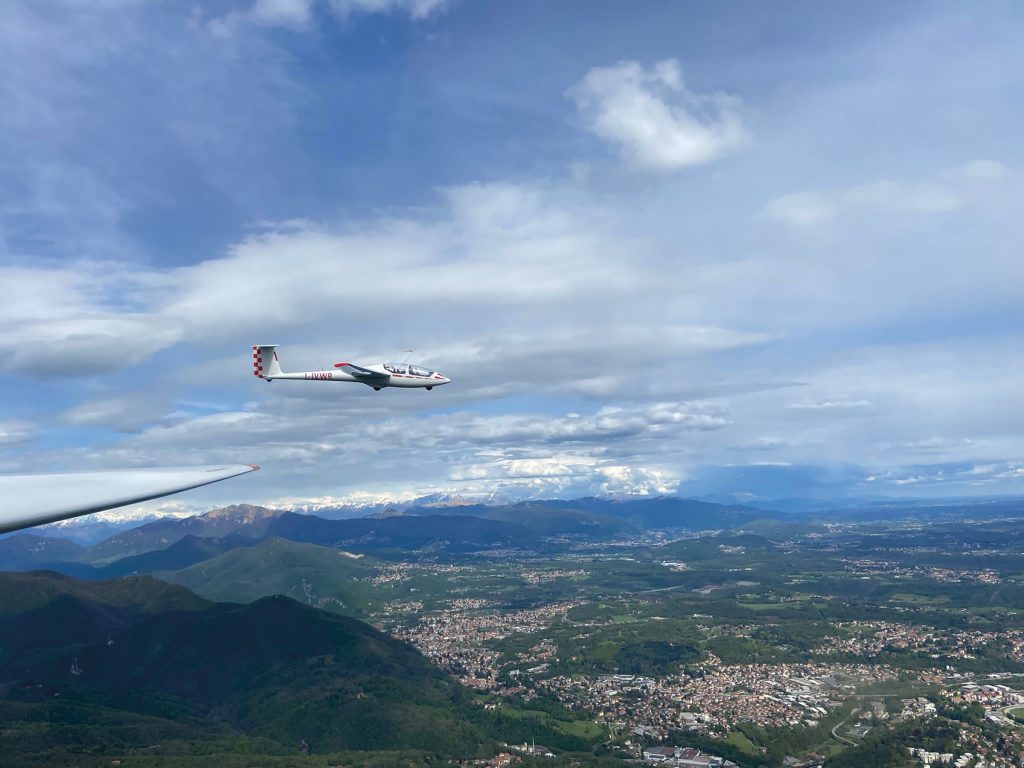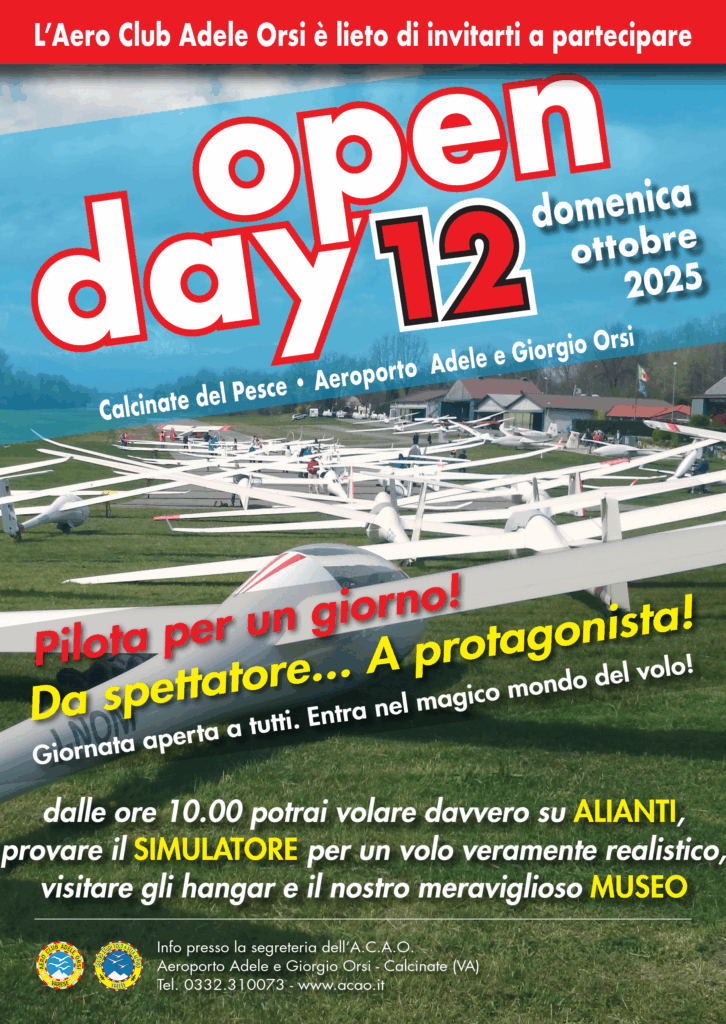The activity of Gliding
Practicing “Glider Flying” means flying a sailplane without the use of mechanical propulsion apparatus. A good flyer sees the air around him as a huge reservoir from which to draw the energy he needs. The forces of nature are at his disposal, if he has learned not to fear them but rather to respect them, to listen to them, and to grasp their slightest signs with undivided attention.
The glider is currently the ultimate practical expression of more than a century of aerodynamic knowledge: the lift generated by the most modern wings is more than 60 times greater than the drag opposed to the advancement (we define this concept by the term “1 to 60 efficiency”). In other words, for every 100 meters of altitude lost such a glider travels 6 kilometers in distance. Even the designers of modern jetliners adopt aerodynamic solutions extrapolated from the aerodynamic studies of modern sailplanes.
A sailplane to take off can use various devices or systems; for example, towing a powered aircraft or by the pull exerted by a cable (up to a couple of kilometers long) that quickly coils over a powerful winch fixed to the ground. Once in the air, the glider slowly but surely descends.
In fact, the potential energy possessed by virtue of the altitude reached is transformed into kinetic energy, hence translation velocity, to overcome aerodynamic drag and glide in search of energy. If the pilot can find an area where the air is not static, but rises upward, and he can keep his glider in it, then he will rise with it, gaining altitude again.
Wind is not solely responsible for the vertical movements of an air mass: the sun, on a fine day, warms the ground, and the latter warms the air by a thin layer (a few tens of meters) in contact with it; like a hot air balloon, the warmed air also tends to rise and organize itself into an invisible, narrow ascending column that we call “a thermal.” The experienced pilot keeps his glider within the thermal as long as possible, making a series of spirals exactly like soaring birds such as raptors and storks.
A normal thermal is 100 to 400 meters in diameter, and rises until it reaches an equilibrium altitude that also depends on the temperature difference from the surrounding air; often this means gaining, then rising, for at least 1,000 or even 3,000 meters. If the glider then travels a line parallel to a wind-swept slope, the dynamic activity of the wind rising after beating against the slope will be added to the thermal activity.
Normally when flying in the mountains, the two actions, the thermal action and the dynamic action, are added together. The vertical speed of this ascent can be on the order of 1 to 7 meters per second (3.6 to 25 km/h!!!). Even higher in some cases than a powerful 4-seat touring aero with a 200-horsepower engine.

The intangibility of air may make the energies that nature brings into play seem modest, but if a cubic meter of air weighs 1,300 grams then even the smallest thermal has a mass of more than a thousand tons. This huge mass of hot air then rises faster than a powerful elevator and can safely lift all the gliders and birds that enter it. While in all motor sports, sooner or later, the thrust of the engine creates habit and ceases to amaze, the thrill that grips the gliding pilot is intense and endless: the atmosphere is alive and communicates to him sensations that bring him closer to the most majestic birds; the gliding pilot is not just a pilot, he is a man with wings.
As experience grows, today a flyer can aspire to destinations that seem surreal. The world altitude record is over 14,000 meters, but far more important is the distance record of 2042 kilometers traveled in a single day (at night, without the sun’s energy, gliders do not fly); the average speed record over a 500km course is 205 km/h. None of these values are destined to last long. Hundreds of attempts are made each year for new world or national records. Italy.
Any good pilot, after a couple of years of experience, can fly several hundred kilometers in a normal day, without incurring exaggerated costs and using the fleet of a flying club.
What differentiates one model from another is the value of the glide angle in still air at constant speed. The greatest distance is achieved by maintaining what is called the “speed of maximum efficiency,” which is a parameter specific to each model, and “efficiency” is defined as the ratio of altitude to distance. This makes it necessary, in the case of competitions, to divide into classes, so as to group together homogeneously, means of similar performance.
Today there are 6 classes, in which common parameters are defined.
The “Club” class consists of gliders of an older generation with a height/plane ratio (efficiency) between 35 and 40. Retractable landing gear is allowed, but not the addition of water ballast to aid fast flight. The “Standard” class groups gliders with a wingspan of 15 meters, fixed profile, retractable landing gear and permissible water ballast. The efficiency is between 40 and 43.
The “Corsa” class is characterized by a 15-meter wingspan and has a variable profile: in fact, flaps are allowed, allowing slower spiral flight and faster flight with less aerodynamic drag. The cart is retractable and water ballast is allowed. The efficiency is between 43 and 45.
The “18-meter” class in which the only limitation is the wingspan: otherwise the same as for the racing class applies. The efficiency is between 48 and 50.
The “Free” class, in which there is no limitation whatsoever and the wingspan varies between 20 and 30 meters. These are gliders that achieve the highest height-to-glide ratios, normally greater than 50 and , in newer machines, greater than 60.
For the past 4 years, a new class has been created: the “World class” in which a “monotype” is used, all gliders are equal and must have the same weight at takeoff: lighter pilots, are obliged to load fixed lead ballasts to make up the difference with the heavier one.
The FAI (http://www.fai.org/ Federation Aeronautique international) has defined a series of tests to qualify the experience and licensing of Gliding pilots.
Such evidence can be summarized as follows:
- Silver insignia-emblazoned patent for the pilot who has achieved the following goals within just two flights:
1st flight:-Stay in the air for at least 5 consecutive hours calculated from the time of release at altitude
2nd flight:-Making a transfer of at least 50 km with an altitude gain from the release point of at least 1000 meters (release must be made at a maximum altitude of 500 meters above the starting point) - Gold insignia-emblazoned license for the pilot who, having attained the silver insignia, has successively achieved the following goals within one or two flights:
1st:-performing a 300-km route around 4 predetermined geographical points before takeoff.
2°:-Gain in altitude of at least 3000 meters - patents emblazoned with gold insignia can be enriched with a “Diamond” by achieving each of the following:
1st:-performing a 300-km route around 3 predetermined geographical points before takeoff.
2nd:-Gain in altitude of at least 5,000 meters
3rd:-performing a 500-km route around 3 predetermined geographical points before takeoff.
In conclusion, we invite you to come to our airport to personally see these wonderful machines that enable man to realize one of his greatest dreams: flying! Yes, flying in silence and trying to “do with reasoning what birds of prey do with instinct.”
Information taken from the Italian Gliding Federation website
